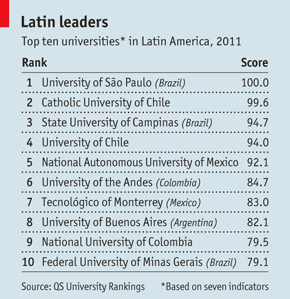
Universities in Latin America
The struggle to make the grade
October 8, 2011 - Economist
If only more of the region's higher-education institutions were like the University of São Paulo
SÃO PAULO – LATIN AMERICA boasts some giant universities and a few venerable ones: the University of Buenos Aires (UBA) and the National Autonomous University of Mexico (UNAM) enroll several hundred thousand students apiece, while Lima's San Marcos was founded in 1551. Even so, the region is hardly synonymous with excellence in higher education. Research output is unimpressive, teaching techniques are old-fashioned and students drop out in droves. These failings matter. Faster economic growth is driving a big rise in demand for higher education in the region and a large crop of new universities. Now, at last, comes an effort to assess the quality of Latin American higher education.
 On October 4th Quacquarelli Symonds, an education consultancy, published the first regional ranking of Latin American universities, combining measures of reputation, research output, academics' qualifications and staff-student ratios. Of the 200 top universities, 65 are in Brazil, 35 in Mexico, 25 apiece in Argentina and Chile and 20 in Colombia (see table for the top ten). The University of São Paulo (USP), the richest and biggest university in Brazil's richest state, came top.
On October 4th Quacquarelli Symonds, an education consultancy, published the first regional ranking of Latin American universities, combining measures of reputation, research output, academics' qualifications and staff-student ratios. Of the 200 top universities, 65 are in Brazil, 35 in Mexico, 25 apiece in Argentina and Chile and 20 in Colombia (see table for the top ten). The University of São Paulo (USP), the richest and biggest university in Brazil's richest state, came top.
This week USP won another plaudit, becoming the only Latin American university to make it into the world's top 200 universities in another much-watched list, published by Times Higher Education, a British specialist weekly. USP ranked 178th this year (up from 232nd last year). Founded and supported by the government of São Paulo state, USP's climb up the rankings has been helped by a big increase in private funding and in international collaborations and recognition. It also led the Latin American contingent in another list, this time compiled by Shanghai's Jiao Tong University and released in August, ranking in the cluster between 101st and 150th. This list focuses on scientific research; USP is becoming a world leader in tropical medicine, parasitology and biofuels.
Nowhere else in Latin America can match USP. The other leaders in the region are a mix of old-established public universities (the University of Chile, for example), Catholic institutions or secular non-profit places such as Bogotá's University of the Andes and Monterrey's Tecnológico.
University rankings miss hard-to-measure factors such as the quality of teaching and the campus atmosphere. They are biased towards bigger universities, which tend to be better known and to produce more research. (This may have helped Argentina's UBA, whose glory days are in the past.) But what they do capture matters. In their different ways they try to identify beacons of excellence and innovation. When they agree, as with USP's regional pre-eminence, it is worth taking note.
These regional rankings might also break down the insularity that has long been a mark of Latin American academia. "Across the region, good students are recruited to faculty at their own universities, rather than encouraged to leave and broaden their horizons," says Jamil Salmi, a higher-education specialist at the World Bank. "And there's a hostility to the very notion you might hire faculty from abroad."
At many Latin American public universities students pay nothing, staff are unsackable, and the curriculum is old-fashioned and politicised. Good teaching and research are not rewarded with extra funding or promotions; institutions do not lose money if their students drop out. Except in Brazil many faculty members are part-timers without PhDs.
In the past three decades, governments have accepted a huge expansion of private provision, much of it by for-profit outfits. That has allowed them to expand higher education quickly without spending more, but before they decided what made a good university, says Francisco Marmolejo, a Mexican consultant on university administration. The result is that mechanisms to ensure quality are weak or nonexistent. Poor youngsters who attend the mainly awful state schools usually end up in these places, paying through the nose.
No country in the region has worked out satisfactorily how to share the cost of degrees between students and taxpayers. Chile's government is currently suffering the consequences. Months of student protests against the exorbitant cost of for-profit universities have seen the popularity of the president, Sebastián Piñera, plunge. The country's education system, from primary school to university, is probably the region's best. But Chile also has one of world's lowest levels of public funding for higher education, some of the longest degrees and no comprehensive system of student grants or subsidised loans. When a flat jobs market was added to this mix, it became combustible.
In Venezuela Hugo Chávez's government has expanded higher education by forcing existing universities to accept a massive increase in student numbers, and by setting-up a giant new open-access state institution, the "Bolivarian University". This is supposed eventually to have around 200 campuses. The result, says Mr Marmolejo, is a "time-bomb". "Unprepared institutions; non-existent infrastructure; 300 students in classrooms that used to hold 15. You end up with a system where hundreds of thousands of people have degrees that are totally worthless."
If Latin America's universities are to flourish their governance must be reformed, says Philip Altbach, director of the Centre for International Higher Education at Boston College in the United States. "In most countries the flagship public universities are simply too big to be managed," he says. Creating a world-class modern university needs flexibility in hiring, promotion and pay rather than the rigid rules that are traditional in the region.
Stronger mechanisms to ensure quality and more equitable student financing would also make a big difference, says Andreas Schleicher of the OECD, an organisation of mainly rich countries. He is optimistic that USP's growing pre-eminence could show the way for the entire region. "No one in the United States tries to figure out what a great university is; they just look at the Ivy League," he says. "It's very important to have great institutions: they define success."